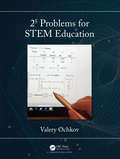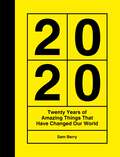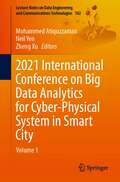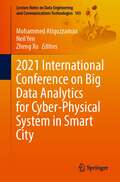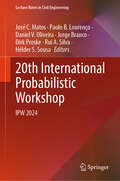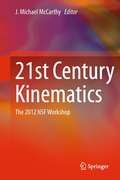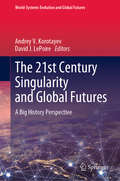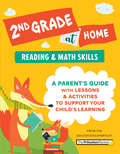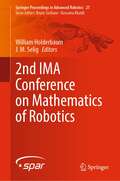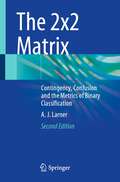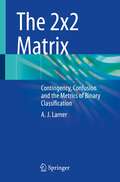- Table View
- List View
2⁵ Problems for STEM Education
by Valery Ochkov25 Problems for STEM Education introduces a new and emerging course for undergraduate STEM programs called Physical-Mathematical Informatics. This course corresponds with the new direction in education called STE(A)M (Science, Technology, Engineering, [Art] and Mathematics). The book focuses on undergraduate university students (and high school students), as well as the teachers of mathematics, physics, chemistry and other disciplines such as the humanities. This book is suitable for readers who have a basic understanding of mathematics and math software. Features Contains 32 interesting problems (studies) and new and unique methods of solving these physical and mathematical problems using a computer as well as new methods of teaching mathematics and physics Suitable for students in advanced high school courses and undergraduates, as well as for students studying Mathematical Education at the Master’s or PhD level One of the only books that attempts to bring together ST(E)AM techniques, computational mathematics and informatics in a single, unified format
2014 Ready Common Core Mathematics Instruction 7
by Curriculum Associates Llc.NIMAC-sourced textbook
2014 Ready Common Core, Mathematics Instruction [Grade] 1
by Curriculum Associates Llc.NIMAC-sourced textbook
2014 Ready Common Core, Mathematics Instruction [Grade] 2
by Curriculum Associates Llc.NIMAC-sourced textbook
2014 Ready Common Core, Mathematics Instruction [Grade] 3
by Curriculum Associates Llc.NIMAC-sourced textbook
2014 Ready Common Core, Mathematics Instruction [Grade] 4
by Curriculum AssociatesNIMAC-sourced textbook
2014 Ready Common Core, Mathematics Instruction [Grade] 5
by Curriculum AssociatesNIMAC-sourced textbook
2014 Ready Common Core, Mathematics Instruction [Grade] 6
by Curriculum Associates Llc.NIMAC-sourced textbook
2014 Ready Common Core, Mathematics Instruction [Grade] 8
by Curriculum AssociatesNIMAC-sourced textbook
2014 Ready Common Core, Mathematics Practice [Grade] 7
by Curriculum Associates Llc.NIMAC-sourced textbook
2014 Ready New York CCLS Common Core: Mathematics Practice (Grade #4)
by Curriculum AssociatesThis 2014 Edition contains 2 full-length practice tests, resembling the same question format and difficulty level as in the actual NYS Math Exam.
2014 Ready New York CCLS Common Core Math Instruction Grade 8 (Ready)
by Curriculum AssociatesReady New York CCLS Common Core will ensure that every classroom is current, focused, and on track with the CCSS initiative! Lessons introduce key skills and use examples to walk students through the math concepts, step by step. You'll get both targeted review and extensive practice on open-ended questions.
2014 Ready TNCore, Mathematics Instruction [Grade] 5
by Curriculum Associates LlcNIMAC-sourced textbook
2014 Ready TNCore, Mathematics Instruction [Grade] 7
by Curriculum AssociatesNIMAC-sourced textbook
2014 Ready TNCore, Mathematics Instruction [Grade] 8
by Curriculum Associates Llc.NIMAC-sourced textbook
2020: Twenty Years of Amazing Things That Have Changed Our World
by Sam BerryCan you recall the year that the Dracula fish was discovered?Do you know the height and location of the world’s tallest building?Remember the company that discovered a way to convert water and CO2 into fuel?This unique trivia compendium presents an illustrated snapshot of the world twenty years after the new millennium.Taking stock of the most impressive achievements, terrific disasters and marvellous innovations that have changed our world, 2020 brings together top twenties of fascinating facts and figures on subjects ranging from life-saving technological advancements to freak weather phenomena, outstanding sporting achievements to unexpected political shake-ups. Whatever your interests, you’ll be amazed, amused, surprised and enlightened by this testament to the catastrophic lows and unbelievable highs of human endeavour.
2021 International Conference on Big Data Analytics for Cyber-Physical System in Smart City: Volume 1 (Lecture Notes on Data Engineering and Communications Technologies #102)
by Mohammed Atiquzzaman Neil Yen Zheng XuThis book gathers a selection of peer-reviewed papers presented at the third Big Data Analytics for Cyber-Physical System in Smart City (BDCPS 2021) conference, held in Shanghai, China, on Nov. 27, 2021. The contributions, prepared by an international team of scientists and engineers, cover the latest advances made in the field of machine learning, and big data analytics methods and approaches for the data-driven co-design of communication, computing, and control for smart cities. Given its scope, it offers a valuable resource for all researchers and professionals interested in big data, smart cities, and cyber-physical systems.
2021 International Conference on Big Data Analytics for Cyber-Physical System in Smart City: Volume 2 (Lecture Notes on Data Engineering and Communications Technologies #103)
by Mohammed Atiquzzaman Neil Yen Zheng XuThis book gathers a selection of peer-reviewed papers presented at the third Big Data Analytics for Cyber-Physical System in Smart City (BDCPS 2021) conference, held in Shanghai, China, on Nov. 27, 2021. The contributions, prepared by an international team of scientists and engineers, cover the latest advances made in the field of machine learning, and big data analytics methods and approaches for the data-driven co-design of communication, computing, and control for smart cities. Given its scope, it offers a valuable resource for all researchers and professionals interested in big data, smart cities, and cyber-physical systems.
20th International Probabilistic Workshop: IPW 2024 (Lecture Notes in Civil Engineering #494)
by Dirk Proske Paulo B. Lourenço Jorge Branco José C. Matos Daniel V. Oliveira Rui A. Silva Hélder S. SousaThis volume presents the proceedings of the 20th International Probabilistic Workshop (IPW), which was held in Guimarães, Portugal on May 8-10, 2024. Probabilistic methods are currently of crucial importance for research and developments in the field of engineering, which face challenges presented by new materials and technologies and rapidly changing societal needs and values. Contemporary needs related to, for example, performance-based design, service-life design, life-cycle analysis, product optimization, assessment of existing structures and structural robustness give rise to new developments as well as accurate and practically applicable probabilistic and statistical engineering methods to support these developments. These proceedings are a valuable resource for anyone interested in contemporary developments in the field of probabilistic engineering applications.
21st Century Kinematics: The 2012 NSF Workshop
by J. Michael Mccarthy21st Century Kinematics focuses on algebraic problems in the analysis and synthesis of mechanisms and robots, compliant mechanisms, cable-driven systems and protein kinematics. The specialist contributors provide the background for a series of presentations at the 2012 NSF Workshop. The text shows how the analysis and design of innovative mechanical systems yield increasingly complex systems of polynomials, characteristic of those systems. In doing so, it takes advantage of increasingly sophisticated computational tools developed for numerical algebraic geometry and demonstrates the now routine derivation of polynomial systems dwarfing the landmark problems of even the recent past. The 21st Century Kinematics workshop echoes the NSF-supported 1963 Yale Mechanisms Teachers Conference that taught a generation of university educators the fundamental principles of kinematic theory. As such these proceedings will provide admirable supporting theory for a graduate course in modern kinematics and should be of considerable interest to researchers in mechanical design, robotics or protein kinematics or who have a broader interest in algebraic geometry and its applications.
The 21st Century Singularity and Global Futures: A Big History Perspective (World-Systems Evolution and Global Futures)
by Andrey V. Korotayev David J. LePoireThis book introduces a 'Big History' perspective to understand the acceleration of social, technological and economic trends towards a near-term singularity, marking a radical turning point in the evolution of our planet. It traces the emergence of accelerating innovation rates through global history and highlights major historical transformations throughout the evolution of life, humans, and civilization. The authors pursue an interdisciplinary approach, also drawing on concepts from physics and evolutionary biology, to offer potential models of the underlying mechanisms driving this acceleration, along with potential clues on how it might progress. The contributions gathered here are divided into five parts, the first of which studies historical mega-trends in relation to a variety of aspects including technology, population, energy, and information. The second part is dedicated to a variety of models that can help understand the potential mechanisms, and support extrapolation. In turn, the third part explores various potential future scenarios, along with the paths and decisions that are required. The fourth part presents philosophical perspectives on the potential deeper meaning and implications of the trend towards singularity, while the fifth and last part discusses the implications of the Search for Extraterrestrial Intelligence (SETI). Given its scope, the book will appeal to scholars from various disciplines interested in historical trends, technological change and evolutionary processes.
2nd Grade at Home: A Parent's Guide with Lessons & Activities to Support Your Child's Learning (Math & Reading Skills) (Learn at Home)
by The Princeton ReviewLearn at home with help from the education experts at The Princeton Review! 2ND GRADE AT HOME provides simple, guided lessons and activities that parents can use to help keep 2nd graders on track this year.Anxious about remote learning and hybrid schooling? Worried that the unique circumstances around coronavirus and education might keep your child from getting the help they need in class this year? Want to help support your child's schooling, but not sure where to start?You're not alone! 2ND GRADE AT HOME is a parent guide to supporting your child's learning, with help you can undertake from home. It provides: · Guided help for key 2nd grade reading and math topics· Skills broken into short, easy-to-accomplish lessons· Explanations for parents, plus independent question sets for kids· Fun at-home learning activities for each skill that use common household items· Parent tips, review sections, and challenge activities seeded throughout the bookThe perfect mix of parent guidance, practical lessons, and hands-on activities to keep kids engaged and up-to-date, 2ND GRADE AT HOME covers key grade-appropriate topics including:· early reading comprehension · context & understanding· event order· fiction & nonfiction· place value· addition and subtraction· multiplication· patterns and shapes· charts & graphs· likelihoood ... and more!
2nd IMA Conference on Mathematics of Robotics (Springer Proceedings in Advanced Robotics #21)
by William Holderbaum J. M. SeligThis book highlights the mathematical depth and sophistication of techniques used in different areas of robotics. Each chapter is a peer-reviewed version of a paper presented during the 2021 IMA Conference on the Mathematics of Robotics, held online September 8–10, 2021. The conference gave a platform to researchers with fundamental contributions and for academic and to share new ideas. The book illustrates some of the current interest in advanced mathematics and robotics such as algebraic geometry, tropical geometry, monodromy and homotopy continuation methods applied to areas such as kinematics, path planning, swam robotics, dynamics and control. It is hoped that the conference and this publications will stimulate further related mathematical research in robotics.
The 2x2 Matrix: Contingency, Confusion and the Metrics of Binary Classification
by A. J. LarnerThis book describes, extends, and illustrates the metrics of binary classification through worked examples.Worked examples based on pragmatic test accuracy study data are used in chapters to illustrate relevance to day-to-day clinical practice. Readers will gain an understanding of sensitivity and specificity and predictive values along with many other parameters.The contents are highly structured, and the use of worked examples facilitates understanding and interpretation.This book is a resource for clinicians in any discipline who are involved in the performance or assessment of test accuracy studies and professionals in the disciplines of machine learning or informatics wishing to gain insight into clinical applications of 2x2 tables.
The 2x2 Matrix: Contingency, Confusion and the Metrics of Binary Classification
by A.J. LarnerThis book presents and discusses the numerous measures of test performance that can be derived from 2x2 tables. Worked examples based on pragmatic test accuracy study data are used in chapters to illustrate relevance to day-to-day clinical practice. Readers will gain a good understanding of sensitivity and specificity and predictive values along with many other parameters.The contents are highly structured and the use of worked examples facilitates understanding and interpretation. This book is a resource for clinicians in any discipline who are involved in the performance or assessment of test accuracy studies, and professionals in the disciplines of machine learning or informatics wishing to gain insight into clinical applications of 2x2 tables.
